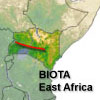 



Weather data
A large number of automatic weather stations has been implemented in the frame of the BIOTA AFRICA project by the Namibian National Botanical Research Institute (NBRI) and the Group "Biodiversity, Evolution and Ecology" (BEE) of the University of Hamburg. The website offers hourly updates of data and graphs of a large number of weather parameters.

|
 BIOTA East Africa - Cross-cutting themes
BIOTA East Africa - Cross-cutting themes
| CCT - Theme 1 |
Monitoring and assessment of biodiversity in space and time |
| CCT Description |
It is intended to deliver reliable data sets certified by experts on the history of changes and the actual state, composition and extension of Kakamega rain forest habitats and on surrounding rural areas, including an inventory of medicinal forest plants. The current state of long term monitoring sites recommended for future observation will be described.
During the previous periods of field work many samples of animals and plants were collected, lists of species were compiled and the distribution of vegetation types was recorded. It is now necessary to finalize and deliver easy-to-use keys to species (digital and on paper), data bases for access via internet, a field guide for forest visitors (tourists and schools).
Spatial correlation of all information based on existing samples and satellite images will provide the data base for a participatory forest management plan of the Kakamega area. Since the continuation of inventorying and monitoring is desperately desired by our counterparts, a contribution of BIOTA East will be to test and recommend just emerging innovative methods (DNA barcoding and image analyses) to considerably speed-up biodiversity inventorying and monitoring. |
| E02 - GIS and Remote Sensing in Support of Biodiversity Management at the Landscape Scale for Rainforests in Eastern Africa |
| Details |
WP1 |
Finalizing the BIOTA-East-GIS (data integration, user interface development, training) and geodata visualization |
| Details |
WP2 |
Spatial extrapolation of BIOTA-East findings on biodiversity and ecosystem function predominantly over Kakamega Forest, plus interdisciplinary analyses considering spatial information |
| Details |
WP3 |
Identifying structural parameters and modelling socio-economic scenarios for the farmland surrounding Kakamega Forest as well as deriving a detailed up-to-date vegetation map for Kaka-mega Forest as a contribution to forest management |
| E03 - Regeneration of tropical trees - implications for forest conservation |
| Details |
WP2 |
Long-term observations on tree growth and natural seedling recruitment |
| Details |
WP3 |
Experimental restoration and rehabilitation of degraded forest sites and threatened tree species |
| E04 - Flora and vegetation of rainforests in East Africa - conservation and sustainable use |
| Details |
WP1 |
GIS-based vegetation mapping of Kakamega and Budongo Forest - Monitoring and assessment of biodiversity |
| Details |
WP2 |
Distribution and abundance of plant species originating from Kakamega Forest in farms and agricultural landscape elements |
| Details |
WP3 |
Medicinal plants of Kakamega and Budongo Forest |
| E10 - Towards conservation and sustainable use of pollinators |
| Details |
WP1 |
Measures of pollinator conservation and long-term monitoring of bees |
| Details |
WP2 |
Effects of landscape structure and habitat fragmentation on plant-pollinator interactions |
| Details |
WP3 |
Automated identification system for East African bees |
| E11 - Human impact on avian diversity, seed dispersal and regeneration processes of East African rainforests: management tools and recommendations |
| Details |
WP1 |
Ficus-diversity as indicator for biodiversity and ecosystem functioning at different spatial scales |
| Details |
WP2 |
Management for high genetic diversity in Prunus africana: seed dispersers vs. pollinators |
| Details |
WP3 |
Multi-disciplinary analysis of data on biodiversity and ecosystem functions |
| Details |
WP5 |
Conservation education and outreach to Kenyan partners |
| E15a - Capacity building in biodiversity information systems for animals and plants in East Africa |
| Details |
WP1 |
Building of BIOTA E15 technical Infrastructure at NMK |
| Details |
WP3 |
Capacity building and sustainable management of zoological BIOTA-East specimen- and observation data |
| E15b - Capacity building in biodiversity information systems for animals and plants in East Africa |
| Details |
WP3 |
NMK - a regional centre of excellence for biodiversity informatics and a provider of biodiversity data |
| E16 - Ant and termite communities along a habitat degradation gradient: patterns and consequences for ecosystem function |
| Details |
WP1 |
Enhancing tools and scientific capacity for monitoring ants and termites |
| Details |
WP2 |
Diversity and abundance of ants and termites along a habitat degradation gradient |
| Details |
WP3 |
Trophic ecology of ants and termites |
| Details |
WP4 |
Ant predation and herbivore-control: from rainforest to intensively used farmland |
| Details |
WP5 |
Use of farmland habitat, temperature tolerance and the survival of ant species in forest fragments |
| Details |
WP6 |
Effects of termite diversity on decomposition rates |
|
|






 Go to the WeatherNet
Go to the WeatherNet BIOTA East Africa - Cross-cutting themes
BIOTA East Africa - Cross-cutting themes